tonyX
New member
hi, newbie on this group here, should have joined earlier. Anyway I have a '74 X 1/9, the ones here in NZ are UK spec vehicles. Obviously it is (was ) a 1300/4spd, which was embarassingly slow on hills, so Ive transplanted a 1500/5spd unit to which Ive done a little work. Firstly for anyone interested, yes the new unit does more or less drop straight in without any metal needing to be cut, but (I found) you also need the 5spd drive shafts, as the 4 spd uses those tripode type things. Ive had some head work done, and a 'fast road' cam regrind, by ppl here who are generally held to be reliable (Harris Developments and Franklin Cams, respectively, but obviously that wont mean anything to anyone outside NZ). I also fitted a single 40 DCNF, mounted on an enlarged standard manifold, so yes it does have a lean bog on a RH corner. Work in progress. I had a tubular exhasut manifold made up mainly to avoid hot-start issues, having a huge heat sink right under the carb isnt a good idea. A few pics attached (or should be, this is the first post Ive made).
But my specific question is this. It seems to run out of puff at about 5500 rp, just no point in going any further - midrange torque is great, a pleasure to drive, but just wont really wind out. Would there be benefit in a double DCNF setup? And if so, why is there benefit. Surely with the single setup, at any one time, each cylinder is sucking on both barrels: with a double setup, the same is true as the carbs dont 'talk' to each other (ie no balance tube or anything, as far as I can see). Is the benefit from intake geometry? Or am I wrong with the balance tube observation. Perhaps there is something fundamental I dont understand. many thanks for any advice!
But my specific question is this. It seems to run out of puff at about 5500 rp, just no point in going any further - midrange torque is great, a pleasure to drive, but just wont really wind out. Would there be benefit in a double DCNF setup? And if so, why is there benefit. Surely with the single setup, at any one time, each cylinder is sucking on both barrels: with a double setup, the same is true as the carbs dont 'talk' to each other (ie no balance tube or anything, as far as I can see). Is the benefit from intake geometry? Or am I wrong with the balance tube observation. Perhaps there is something fundamental I dont understand. many thanks for any advice!




